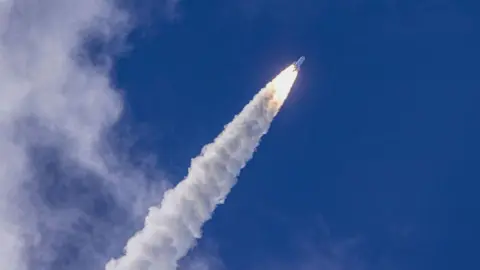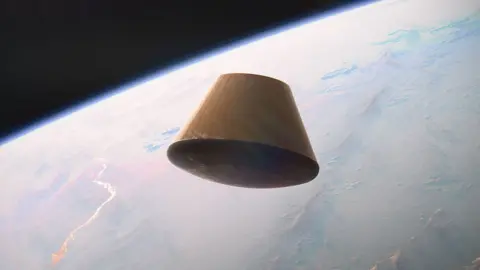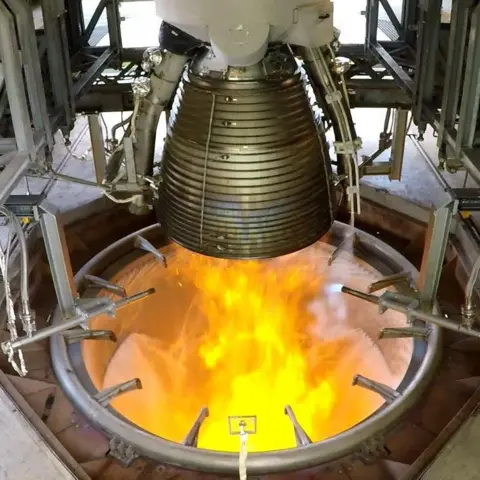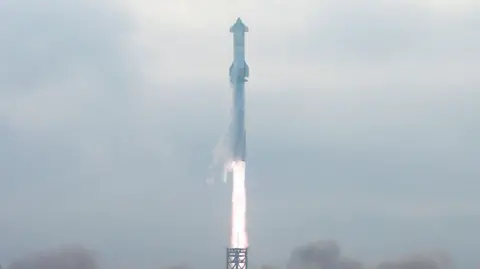 AFP
AFPEurope’s massive ancient rocket, the Ariane-6, has successfully taken off on its maiden flight.
Sparks fly from a launchpad in an automobile French Guiana signals on a project to put into orbit native generation satellites around 16:00 (19:00 GMT).
The workers at Kourou’s garden applauded as the rocket flew into the sky.
Upgraded at a cost of €4bn (£3.4bn), the Ariane-6 is a workhorse rocket that will allow EU governments and companies to fly independently from what remains of the region.
It already has a backlog of setting commitments, although there are concerns that its design could restrict life chances.
Like its predecessor, the Ariane-5, the ancient style is single-use – each project requires an ancient rocket, whereas real American cars are being built to be fully or partially reusable. Is.
Nevertheless, EU range officials believe Ariane-6 can carve out a niche for itself.
“This is a big moment,” said Joseph Eschbacher, director general of the EU Length Company (ESA).
“Daily life today really depends on information received from satellites, from telecommunications and Earth observation to weather forecasting and disaster management. It is unthinkable for Europe not to have guaranteed free access to space,” he advised BBC News. “

On the surface, the 6 appears to be very similar to the used 5, although on the outside it uses cutting-edge production methods (3-D printing, friction stir welding, augmented reality design, etc.) that are quicker and less Promote cost-effective manufacturing.
Ariane-6 will operate in two configurations:
- “62” will include two solid-fuel aspect boosters to lift medium-sized payloads.
- “64” can have 4 strap-on boosters to lift the heaviest satellites available on the market
The core degree is complemented with a second, or higher degree, which can operate payloads to their precise orbits above the Earth.
This level can be controlled and restarted a few times, which becomes useful when launching large batches of satellites into a constellation or network. The regeneration ability additionally allows the level to be pulled in the direction opposite to Earth, so it will not become a long-lived junk job.
The Ariane-62 variant was worn in Tuesday’s project. The rocket will climb to an altitude of 580 km before construction to dump the free-flying payload.
They are a mix of college and commercial spacecraft. They come with two bullets that can attempt to continue rapid degradation throughout the atmosphere to rapidly spread across the Pacific.
Some pills, matching the name Nix Bikini, are a small-scale demonstrator from a Franco-German company that aims to eventually build spacecraft that will deliver supplies and family to range stations in Earth orbit.
Ariane 6 vs Falcon 9
Inaugural flights are always events of great danger. It is no longer unusual for an ancient rocket design to fail.
The Ariane-5 blew itself up 37 seconds before it left orbit during its 1996 launch. The loss was caused by an error in control equipment.
However, a modified rocket again dominated the economic installation market for the world’s largest satellites. That dominance was only broken in the 2010s by American entrepreneur Elon Musk and his reusable Falcon-9 rockets.
Falcon gliding fees and costs reduce the competitiveness of Ariane-5.
 ESA
ESAEurope is moving towards reusability, although important applied sciences will not be in service until the 2030s. And meanwhile, Mr. Musk is introducing even bigger rockets That word of honor of issuing established values is still superfluous.
Later Ariane-6 enters the more difficult sequence.
“We can all have our own opinions. I can only confirm that we have an order book that is full,” said Lucia Linares, who heads range transportation technology at ESA.
“I think the point here goes to the customers: They have said Ariane-6 is the answer to their needs.”
 Arianegroup
ArianegroupCommitments are being established to stretch the rocket during its first three years of operation. These include 18 launches for Jeff Bezos, another American billionaire, who wants to establish a constellation of Webb satellites, which he calls Kuiper.
EU officials are attempting to fly the Ariane-6 once an hour.
If this gliding duty can also be accomplished, the upcoming rocket will have to be able to determine itself, commented Pierre Lionnet from range consultancy ASD Eurospace.
“First of all, we need to make sure there is enough demand from European customers – European institutional customers. Then Ariane needs to win some commercial customers beyond Kuiper. That will give it a market,” he told BBC Information. .
“But this is a matter of pricing. If the Falcon-9 is systematically undercutting the Ariane-6 price offer, there will be an issue.”
Ariane-6 is a venture of ESA’s 13 member states, led by France (56%) and Germany (21%). The 13 partners have pledged a subsidy bill of up to €340m (£295m) per year to support the early stages of Ariane-6 exploitation.
The United Kingdom was previously a major participant in Europe’s launcher program and an ESA member country, but its direct involvement in Ariane ended when the Ariane-4 model was discontinued in 2003.
Some UK companies continue to supply parts on a commercial basis, and some UK-built spacecraft will undoubtedly continue to fly on Ariane.
 reuters
reutersDiscover more from news2source
Subscribe to get the latest posts sent to your email.





